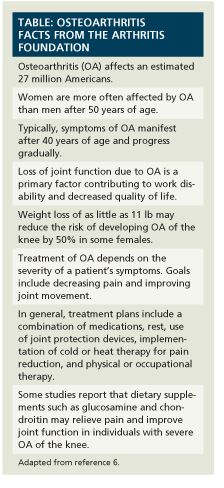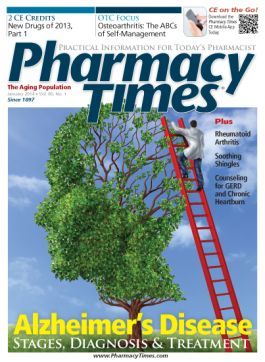Osteoarthritis: The ABCs of Self-Management
Osteoarthritis is considered to be the most common form of arthritis, affecting an estimated 27 million individuals in the United States.
Osteoarthritis is considered to be the most common form of arthritis, affecting an estimated 27 million individuals in the United States.
Osteoarthritis (OA) is a degenerative joint disease that is considered to be the most common form of arthritis. OA is characterized by a gradual softening and degradation/destruction of the cartilage between bones, causing the bones to rub together and resulting in pain and stiffness.1,2
The Arthritis Foundation estimates that 27 million individuals in the United States have some degree of OA (Table). The Centers for Disease Control and Prevention (CDC) estimates that 57 million individuals will have some degree of arthritis by 2030.3-5
Although OA can occur in any joint, it most often affects the weight-bearing joints of the hips and knees, and the lower back.2 OA can also affect the neck, small finger joints, base of the thumb, and big toe.3 Risk factors for OA include increasing age, familial history, joint injury or deformity, and being overweight. According to the CDC, the aging population and the obesity epidemic may be contributing factors to the growing number of OA cases.3-5

In general, the goals for treating OA include relieving pain and enhancing joint mobility to improve the patient’s quality of life.2 According to the Handbook of Nonprescription Drugs, only the pain associated with OA is approved for self-treatment after an initial medical diagnosis is established.1,2 Selection of therapy for the treatment and management of OA often depends on the severity of the symptoms. Therapy frequently employs a combination of pharmacologic agents, physical therapy, rest, heat and cold therapy, weight loss, and devices (eg, canes, splints) or surgery to reduce strain on joints.1,2
Nonprescription analgesics such as nonsteroidal anti-inflammatory drugs (NSAIDs) and acetaminophen (N-acetyl-para-aminophenol) are frequently used to treat OA. Due to its reduced adverse effect profile compared with that of NSAIDs, acetaminophen is the analgesic of choice for treating OA when inflammation is not a major complaint or concern or when no contraindications are present.2 NSAIDs are preferred for use when inflammation is present and there are no contraindications. Prior to initiating therapy with nonprescription analgesics, patients should be screened for potential contraindications and drug interactions.
In addition to systemic analgesics, a plethora of topical products (counterirritants) are available for treating joint pain. Topical agents may be used in conjunction with oral analgesics or as the sole therapy of choice. These topical products may contain 1 or more of the following ingredients: methyl salicylate, camphor, menthol, methyl nicotinate, capsaicin, and trolamine salicylate. Topical products are available as gels, sprays, ointments, creams, lotions, and patches. During counseling, patients should be advised to apply topical products only to skin that is intact and to never cover treated areas with tight bandages or occlusive dressings.2 Patients should not use heating devices in conjunction with topical counterirritants.2 Single-use topical heat therapy patches in various sizes are available for alleviating joint pain by providing 8 to 12 hours of continual heat therapy.
A host of dietary supplements such as glucosamine, chondroitin sulfate, methylsulfonylmethane (MSM), and S-adenosyl-L-methionine (SAM-e) have been used for treating OA and supporting joint health.2,8 Glucosamine and chondroitin are the most popular supplements used for treating OA.2,6,8 Formulations of these supplements are available in single-entity or combination products. Studies have shown that glucosamine sulfate not only reduces pain associated with OA but also may diminish the progression of the disease.6-8
Glucosamine is classified as an endogenous mucopolysaccharide that is used in the synthesis of cartilage.6-8 The most common adverse effects of glucosamine include mild gastrointestinal (GI) upset, nausea, heartburn, and diarrhea, which can be alleviated by taking glucosamine in divided doses with meals.8 Glucosamine should not be used by individuals allergic to shellfish. Diabetics should be aware of the possibility of hyperglycemia when using glucosamine and should consult their physician prior to use.7,8
Chondroitin sulfate is a glucosaminoglycan, naturally present in and around animal cartilage, that helps cartilage retain water.7,8 The most common adverse effects include mild GI upset and nausea.7,8
MSM has also been added to many glucosamine/chrondroitin supplement products. MSM is a sulfur source that is released on breakdown by intestinal bacteria.8 Although its exact mechanism of action with regard to OA is unclear, MSM has a crucial role in maintaining the elasticity and flexibility of the connective tissue that makes up joints.8-10
Patients should be advised that these supplements will not provide pain relief as quickly as NSAIDs or acetaminophen and that the therapeutic effects of these supplements may not be evident for several weeks, so it is imperative to adhere to therapy.8
SAM-e is produced primarily in the liver.8 It is marketed and best known as a mood stabilizer. Liver disease or low levels of vitamin B12 or folate may reduce SAM-e levels.8 SAM-e should not be used in conjunction with antidepressants and 5-HT1 agonists because of an increased risk of serotonin syndrome.8
More information on these supplements and their use in OA can be found at the National Institutes of Health National Center for Complementary and Alternative Medicine website at http://nccam.nih.gov.
The Role of the Pharmacist
Prior to recommending any nonprescription products for OA, pharmacists should evaluate the appropriateness of self-therapy by reviewing the patient’s symptoms, medical history, drug profile, and allergy history. Screening for drug—drug interactions and potential contraindications is also critical. Patients who are taking any other medications, have preexisting conditions, or are pregnant or lactating should always consult a physician before using any of these products.
During counseling, patients should be informed about the proper use and adverse effects of these products. Patients experiencing severe and continual joint pain should be encouraged to seek further evaluation and treatment by their primary health care provider, when warranted, if no signs of improvement are observed, or if pain or mobility worsen. Patients should be reminded that heavy physical activity, repetitive movements, and lifting of heavy weights may exacerbate OA; however, light to moderate activity may be beneficial.2 Pharmacists can make recommendations for nonpharmacologic measures that patients can incorporate into their treatment regimen to help alleviate joint pain; recommendations may include heat or cold therapy, use of supportive devices, and range-of-motion and strength-training exercises.2
Pharmacists can be instrumental in educating patients about the various treatment options for OA; as a result, patients can make informed decisions.
Ms. Terrie is a clinical pharmacy writer based in Haymarket, Virginia.
References
- What is osteoarthritis? National Institute of Arthritis and Musculoskeletal and Skin Diseases website. www.niams.nih.gov/Health_Info/Osteoarthritis/osteoarthritis_ff.asp. Accessed December 4, 2013.
- Olenak J. Musculoskeletal injuries and disorders. In: Krinsky D, Berardi R, Ferreri S, et al, eds. Handbook of Nonprescription Drugs. 17th ed. Washington, DC: American Pharmacists Association; 2012.
- Ten percent of US adults physically limited by arthritis. MedlinePlus website. www.nlm.nih.gov/medlineplus/news/fullstory_142304.html. Accessed December 1, 2013.
- Osteoarthritis. Arthritis Foundation website. www.arthritis.org/conditions-treatments/disease-center/osteoarthritis/. Accessed December 1, 2013.
- Osteoarthritis. US Department of Health and Human Services website. http://report.nih.gov/nihfactsheets/ViewFactSheet.aspx?csid=55. Accessed December 1, 2013.
- Facts about OA. Arthritis Foundation website. www.arthritis.org/files/images/newsroom/media-kits/Osteoarthritis_fact_sheet.pdf. Accessed December 1, 2013.
- Questions and answers: NIH glucosamine/chondroitin arthritis intervention trial primary study. NIH’s National Center for Complementary and Alternative Medicine website. http://nccam.nih.gov/research/results/gait/qa.htm#b2. Accessed December 1, 2013.
- McQueen C. Nonbotanical natural medicines. In: Krinsky D, Berardi R, Ferreri S, et al, eds. Handbook of Nonprescription Drugs. 17th ed. Washington, DC: American Pharmacists Association; 2012.
- Osteo Bi-flex product information. Rexall Sundown website. www.osteobiflex.com/products/. Accessed December 1, 2013.
- TripleFlex product information. Pharmavite Inc website. www.naturemade.com/products/health-solutions/tripleflex-triple-strength. Accessed December 1, 2013.

